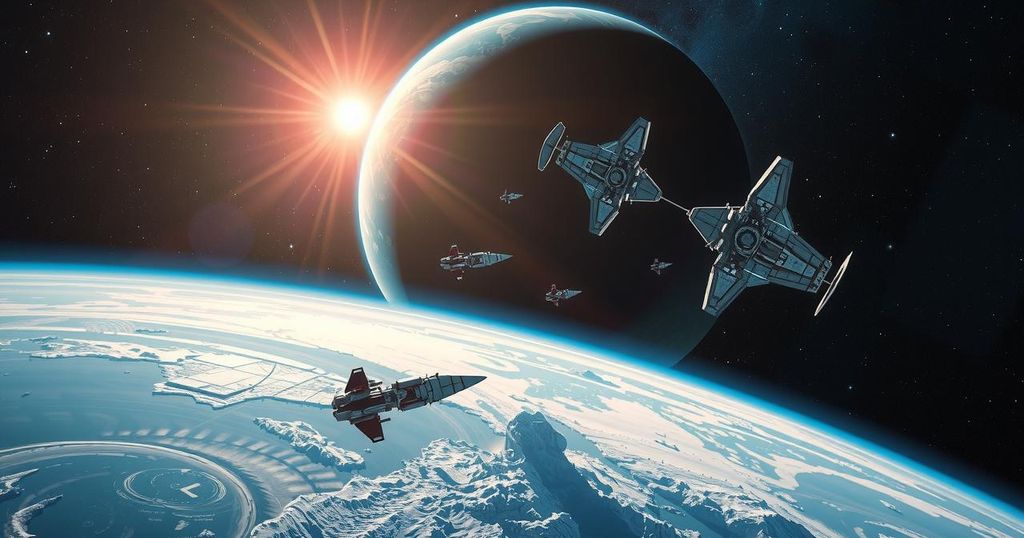India’s Historic Space Docking Mission: A Leap Toward Future Ambitions
India achieved a historic milestone by successfully docking two satellites, Chaser and Target, during the Space Docking Experiment (SpaDeX). This event places India alongside elite space nations and enhances its potential for future missions, including a manned mission to the moon and the creation of a space station. The innovative approach of incorporating private sector contributions marks a progressive shift in ISRO’s operational strategy, aiming for sustained success amid financial constraints.
India accomplished a remarkable milestone by successfully docking two satellites, solidifying its presence in an elite group of spacefaring nations, including the United States, Russia, and China. This event signifies a pivotal advancement in India’s space program, allowing for collaborative satellite operations and resource sharing vital for future ambitious missions. The mission, known as the Space Docking Experiment (SpaDeX), launched on December 30 from the Satish Dhawan Space Centre, showcasing India’s commitment to maximizing efficiency and innovation in its space endeavors.
The SpaDeX mission involved two satellites, Chaser and Target, each weighing approximately 220 kilograms. After their separation at an altitude of 470 kilometers, they performed maneuvers to position themselves for docking about 20 kilometers apart. The successful docking, which was initially set for January 7 but delayed due to drift issues, sparked celebrations at the Indian Space Research Organisation (ISRO) and received commendations from Prime Minister Narendra Modi, who emphasized its significance for future missions.
The successful docking is considered crucial for India’s future space endeavors, with aspirations to send a man to the moon by 2040, develop a space station, and dispatch an orbiter to Venus. Docking technology will facilitate mission-critical tasks like in-orbit refueling and the assembly of heavy structures in microgravity, marking a significant enhancement in ISRO’s operational capabilities amidst its previous achievements in lunar and Martian missions.
Innovative approaches have allowed ISRO to engage private sector entities in the SpaDeX mission, minimizing entry barriers and fostering a collaborative space ecosystem. The integration of experiments from various non-governmental organizations and academic institutions reflects ISRO’s strategic shift toward inclusivity, with emphasis on nurturing the private space industry alongside governmental efforts.
While the Indian space sector experiences fluctuations in funding, with private investment witnessing a decline, government support for ISRO’s projects has increased substantially. The substantial government allocation of 10 billion rupees for ongoing and future missions underscores the recognition of ISRO’s potential even amidst global investment challenges, though experts point out that sustained funding remains essential given the complexities of ambitious space projects ahead.
ISRO’s ability to execute missions at a fraction of the cost of other space agencies illustrates not only budgetary efficiency but also the organization’s innovative prowess. Historical endeavors, such as the Mars orbiter launch and Chandrayaan missions, emphasize a focus on creativity within constrained financial parameters. Visionary leaders like Mylswamy Annadurai advocate for recognizing ISRO’s innovation over frugality as an identity, a sentiment echoed by the academic community advocating for a shift in narrative around India’s space program as it evolves into a key player on the global stage.
India’s recent success in conducting a space docking mission highlights the country’s advancing capabilities in space technology, placing it among the world’s leaders in aerospace innovation. The achievement serves as a cornerstone for upcoming initiatives, including crewed missions and the establishment of a domestic space station. This development is seen as imperative not only for national pride but also for potential international collaborations and technological advancements that can elevate India’s standing in the global space community.
The docking of the Chaser and Target satellites demonstrates India’s growing expertise and ambition in space exploration. As ISRO continues to innovate while operating within fiscal constraints, the organization is shifting its narrative from one of low-cost missions to a focus on technological advancements and collaborative efforts with the private sector. This success sets a solid foundation for future ambitions, including manned space travel and interplanetary exploration, further solidifying India’s position among leading space nations.
Original Source: www.aljazeera.com








Post Comment